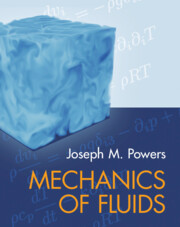Refine search
Actions for selected content:
5487 results in Thermal-fluids engineering
Appendix D - Abbreviated Tables for Isentropic Flow
-
- Book:
- Fundamentals of Jet Propulsion with Power Generation Applications
- Published online:
- 01 September 2023
- Print publication:
- 10 August 2023, pp 628-629
-
- Chapter
- Export citation
10 - Nozzles
- from Part III - Nonrotating Components
-
- Book:
- Fundamentals of Jet Propulsion with Power Generation Applications
- Published online:
- 01 September 2023
- Print publication:
- 10 August 2023, pp 493-526
-
- Chapter
- Export citation
Appendix I - Notes on Iteration Methods
-
- Book:
- Fundamentals of Jet Propulsion with Power Generation Applications
- Published online:
- 01 September 2023
- Print publication:
- 10 August 2023, pp 667-671
-
- Chapter
- Export citation
Part IV - System Matching and Analysis
-
- Book:
- Fundamentals of Jet Propulsion with Power Generation Applications
- Published online:
- 01 September 2023
- Print publication:
- 10 August 2023, pp 547-604
-
- Chapter
- Export citation
6 - Centrifugal Compressors
- from Part II - Rotating Components
-
- Book:
- Fundamentals of Jet Propulsion with Power Generation Applications
- Published online:
- 01 September 2023
- Print publication:
- 10 August 2023, pp 349-380
-
- Chapter
- Export citation
Appendix B - Standard Atmosphere
-
- Book:
- Fundamentals of Jet Propulsion with Power Generation Applications
- Published online:
- 01 September 2023
- Print publication:
- 10 August 2023, pp 606-606
-
- Chapter
- Export citation
Appendix J - Axial Compressor Radial Equilibrium Details
-
- Book:
- Fundamentals of Jet Propulsion with Power Generation Applications
- Published online:
- 01 September 2023
- Print publication:
- 10 August 2023, pp 672-674
-
- Chapter
- Export citation
Part I - Cycle Analysis
-
- Book:
- Fundamentals of Jet Propulsion with Power Generation Applications
- Published online:
- 01 September 2023
- Print publication:
- 10 August 2023, pp 1-250
-
- Chapter
- Export citation
11 - Ducts, Mixers, Exhausts, and Stacks
- from Part III - Nonrotating Components
-
- Book:
- Fundamentals of Jet Propulsion with Power Generation Applications
- Published online:
- 01 September 2023
- Print publication:
- 10 August 2023, pp 527-546
-
- Chapter
- Export citation

Mechanics of Fluids
-
- Published online:
- 14 July 2023
- Print publication:
- 29 June 2023
-
- Textbook
- Export citation
Dedication
-
- Book:
- Dynamics of Flexible Aircraft
- Published online:
- 29 June 2023
- Print publication:
- 13 July 2023, pp vii-viii
-
- Chapter
- Export citation
5 - Dynamics of Flexible Aircraft with Quasi-Steady Deformations
-
- Book:
- Dynamics of Flexible Aircraft
- Published online:
- 29 June 2023
- Print publication:
- 13 July 2023, pp 174-208
-
- Chapter
- Export citation
9 - Dynamics of Very Flexible Aircraft
-
- Book:
- Dynamics of Flexible Aircraft
- Published online:
- 29 June 2023
- Print publication:
- 13 July 2023, pp 354-405
-
- Chapter
- Export citation
Appendix C - Finite Rotations
-
- Book:
- Dynamics of Flexible Aircraft
- Published online:
- 29 June 2023
- Print publication:
- 13 July 2023, pp 469-474
-
- Chapter
- Export citation
Symbols
-
- Book:
- Dynamics of Flexible Aircraft
- Published online:
- 29 June 2023
- Print publication:
- 13 July 2023, pp xviii-xxii
-
- Chapter
- Export citation
1 - Introduction
-
- Book:
- Dynamics of Flexible Aircraft
- Published online:
- 29 June 2023
- Print publication:
- 13 July 2023, pp 1-34
-
- Chapter
- Export citation
7 - Time-Domain Unsteady Aerodynamics for Low-Speed Flight
-
- Book:
- Dynamics of Flexible Aircraft
- Published online:
- 29 June 2023
- Print publication:
- 13 July 2023, pp 277-315
-
- Chapter
- Export citation
Appendix A - The Fourier Transform
-
- Book:
- Dynamics of Flexible Aircraft
- Published online:
- 29 June 2023
- Print publication:
- 13 July 2023, pp 462-465
-
- Chapter
- Export citation
Experimental Testing
-
- Book:
- Dynamics of Flexible Aircraft
- Published online:
- 29 June 2023
- Print publication:
- 13 July 2023, pp 448-461
-
- Chapter
- Export citation
8 - Geometrically Nonlinear Composite Beams
-
- Book:
- Dynamics of Flexible Aircraft
- Published online:
- 29 June 2023
- Print publication:
- 13 July 2023, pp 316-353
-
- Chapter
- Export citation
